Abstract
Forty-two obsidian artifacts excavated at the site of Valdesi in western Sicily were analyzed to determine their geological sources and to reconstruct trade patterns. Non-destructive analysis was performed using a portable, non-destructive X-ray fluorescence spectrometer, with the calibrated element’s composition values compared directly with a dataset of geological samples from the Mediterranean and European sources that were analyzed with the same instrument. The results, based on straightforward X-Y graphs using the trace elements Rb, Sr, Y, Zr, and Nb, showed the presence of obsidian from two subsources on Lipari (Gabellotto Gorge, Canneto Dentro), two on Pantelleria (Balata dei Turchi, Lago di Venere), and one on Sardinia. The majority coming from Lipari coincided with the location of Valdesi, and nearly 20% came from Pantelleria, both consistent with the overall distribution patterns for Sicily, while the one from Sardinia is a unique discovery. These results are discussed in terms of the time period and context for Valdesi, as well as the open-water and land-based routes that must have been taken.
1. Introduction
Obsidian artifacts have been found at many prehistoric archaeological sites in the central Mediterranean, while elemental analyses have separated the four island sources of Lipari, Palmarola, Pantelleria, and Sardinia. Important is that multiple subsources may be chemically distinguished for each of the islands, and there were changes in use over time, at least for Sardinia [1,2]. The ability to conduct scientific, non-destructive analyses within museums and storage facilities has led to far more analyses in recent years and statistically significant comparisons between sites. This study focuses specifically on the site of Valdesi in northwestern Sicily, with the nearest geological sources being the islands of Lipari and Pantelleria, but a surprise discovery was found as well.
2. Geological Background of Monte Pellegrino
During recent prehistory, Monte Pellegrino, the most characteristic and symbolic mountainous landmark of the city of Palermo (Sicily, Italy), hosted numerous human settlements, offering various geomorphologies and topographic traits: caves and rockshelters, flat terraces, and proximity to the sea. Among the sites located on the northwestern slopes of the mount is the settlement of Valdesi, the subject of our study (Figure 1).
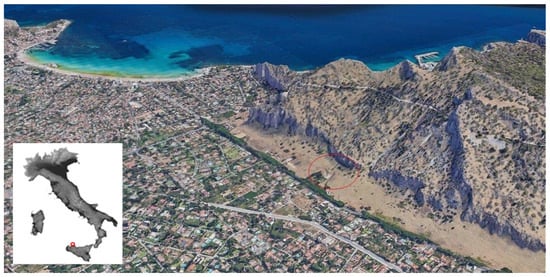
Figure 1.
Inset map of Italy and view of the Gulf of Mondello–Valdesi with the northwestern side of Monte Pellegrino and the area of Valdesi Necropolis (Google Earth). Site is within red circle.
Monte Pellegrino is an isolated relief located northwest of the Gulf of Palermo (Sicily, Italy), which is part of the mountain system surrounding the Piana di Palermo, the vast flat area on which the urban layout of the Sicilian capital has developed (Figure 2). From a geological point of view, Monte Pellegrino is a homogeneous massif made up of carbonate and dolomitic sedimentary rocks, covering an area of about 6.5 sq km with a maximum height of 606 m [3,4].

Figure 2.
The Piana di Palermo and the surrounding mountains. Monte Pellegrino is an isolated relief in the northern area of the Gulf. The Valdesi prehistoric settlement is at the northwestern foot of the mountain (modified from [5]).
The ancient history of the formation of Monte Pellegrino, as well as that of the other relief features of Sicily, begins in the Upper Triassic period (220 Ma). At that time, where Sicily is located today, the Tethys Ocean opened up, characterized by tropical, shallow waters in which sedimentary processes led to the formation of a vast carbonate platform. In subsequent geological eras, these depositional environments were at first involved in extensional and then compressional tectonic movements resulting from the complex interactions between the African and Eurasian crustal plates and their minor articulations [6,7]. The rocks at the bottom of the carbonate platform began to overlap, causing the formation of relief features with covering layers that make up the Sicilian Apennines, of which the Palermo Mountains are a sector.
In more recent geological times, slow uplift movements developed due to compressive tectonic movements that occurred between the Late Pliocene and the Middle Pleistocene periods (3.5–1.5 Ma), leading to the emergence of the Palermo Mountains, including Monte Pellegrino. An incisive hydrographic network developed on the emergent carbonate formations, creating valleys, dismantling large rock volumes, and exhuming the deepest rocks. A network of underground cavities also developed due to the solubility of the carbonate rocks, forming the karst landscape that characterizes Monte Pellegrino and other relief features of the Palermo plain [6,7].
One geological feature of Monte Pellegrino that assumes archaeological importance is the development of numerous caves of karstic origin, often remodeled by marine erosion, that open in the limestone of Monte Pellegrino. These caves are of considerable archaeological interest, as they have preserved lithic and ceramic materials for millennia, which are useful for understanding the prehistoric human presence in northwestern Sicily. The fossil remains of Pleistocene fauna have also been found in these caves [3,4]. Among the many caves of Monte Pellegrino, the Addaura cave, which opens onto the north side of the mountain at 80 m above sea level, is the most important from a prehistoric and paleoanthropological point of view. The cave’s left wall has a complex of engravings that are among the most important and studied of the Late Glacial rock art of Sicily [8]. The main panel depicts a group of human figures arranged in a circle around two central figures with covered heads and arched backs. According to some interpretations, it constitutes a propitiatory dance scene [9].
3. Archaeological Site and Background
The prehistoric village of Valdesi takes its name from Valdesi, the fraction of the Municipality of Palermo close to Mondello, a famous seaside resort in the Sicilian capital. It is a settlement where archaeological excavation campaigns have not yet been performed. Awareness of its existence derives from the fortuitous discovery of a necropolis during land excavation works carried out at the end of the 19th century and from subsequent episodic surface archaeological surveys in the area.
The location of the prehistoric village of Valdesi had been poorly defined: the literature indicates the foothills on the northwestern slope of Monte Pellegrino. The settlement lies buried under a few meters of slope debris accumulated over the millennia; therefore, it is not highlighted by ancient anthropic ruins emerging from the ground nor by any road signs indicating its presence.
Even the chronology of the human occupations of the site is vague: the lithic and ceramic artifacts recovered in the same area attest to a human presence that would have lasted from the Paleolithic to the Chalcolithic [9,10,11,12,13], although the Paleolithic presence very doubtful. The starting point to reach the area of the Valdesi prehistoric village is the street called Via Monte Ercta, where the northern end of Sentiero Landolina begins. Sentiero Landolina is a beaten earth walkway that extends for more than 2 km along the inclined plane of the slope debris at the foot of the western slope of Monte Pellegrino.
At the beginning of the Sentiero Landolina, the panorama is dominated by the so-called Spigolo di Valdesi, a spur of rock about 100 m high that forms the northwestern corner of the limestone massif of Monte Pellegrino. Another unmistakable point of reference is a large casemate built at the foot of Spigolo di Valdesi during the Second World War. The ground around this fortification still yields fragments of bombs and machine gun bullets.
Walking along the Landolina path and proceeding south, one can see the mighty cliff of Monte Pellegrino on the left and on the right, at lower altitudes, Viale Regina Margherita di Savoia, the main tree-lined road that leads from Palermo to the seaside resort of Mondello and vice versa. Except for a few wild olive trees, green shrubs, and low ephemeral vegetation cover, the land surrounding the path is stony and dotted with large boulders that have fallen from the cliff.
Along the Landolina path, one can imagine passing over the buried ruins of the prehistoric settlement, the existence of which is confirmed by the fragments of lithic tools and pottery that, until a few decades ago, were scattered in this surrounding area but are extremely rare today [9,13] (Figure 3).
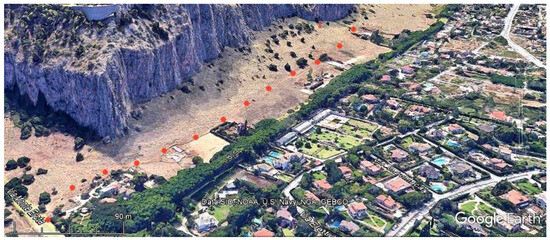
Figure 3.
Aerial photo with red dots highlighting the Sentiero Landolina, the path at the foot of the western slope of Monte Pellegrino that passes over the buried remains of the Valdesi prehistoric settlement and intercepts the necropolis (modified from Google Earth).
Traces of the events that led to the discovery of the prehistoric settlement can be found about 700 m from the beginning of the Landolina Path. Immediately downstream of the pathway there is a deep excavation of land close to a group of red-roofed buildings: this place is where, at the end of the 19th century, large volumes of soil were taken to fill the unhealthy marshes of the nearby areas of Valdesi–Mondello. In 1897, during these excavations, numerous cave tombs were casually intercepted, full of lithic artifacts and pottery of which the excavation workers took possession. Many of the archaeological finds were subsequently recovered by Salinas on behalf of the National Museum of Palermo, paying the workers themselves [9,13]. The preliminary reports and the finds were then studied and published by Jole Bovio Marconi [12]. In more recent times, Mannino [9], who reviewed the collections and carried out numerous surveys of the area, observed that the excavations in this piedmont area at the end of the 19th century were multiple, and as can be seen from the photographic documentation of the time, they intercepted more than one necropolis and various chronological levels. Mannino [9,13] claimed that the collections housed in the Palermo Museum would not take this variety into account “grouping and considering as belonging to the same necropolis finds heterogeneous in terms of material and age” [9]. The geographical coordinates of the median point of the 1897 excavation are: 13°20′06.65″ E–38°11′01.11″ N.
About 60 m upstream of the Landolina pathway, there is the mouth of a small cave, called Grotta del Laghetto due to water dripping from the vault that sometime collects in floor cavities. It opens at the foot of the mountain wall in correspondence with a recess of the rock wall, and its visibility is prevented by some large Mediterranean shrubs. The cave has a rounded mouth about 3 m in diameter, and it enters the mountain for about 9 m, forming a sub-horizontal tubular tunnel. Reconnaissance of the cave, documented from the end of the 19th century, led to the discovery of fragments of impasto terracotta, generically attributed to the prehistoric age, including tools of obsidian, flint, and quartzite [9]. The geographical coordinates of the entrance to the Grotta del Laghetto are 13°20′08.8″ E–38°11′03.2″ N.
From the Grotta del Laghetto, following the foot of the mountain for about 40 m to the south, one comes across a wide and deep furrow in the ground that descends straight down toward the valley and stops before intercepting the Landolina path. The furrow has nothing to do with the excavations of 1897: it is an anti-tank trench built during the Second World War [9,13]. Its trace, still clearly visible today also by aerial and satellite photos, is useful for identifying the necropolis area from above since it is like a finger pointing at it.
The identification of the prehistoric site of Valdesi thus involves three (or more) different places of interest: the talus of a Paleolithic grotto (Grotta del Laghetto), part of a prehistoric village, and a sepulchral area (the “necropolis”) [9,12]. During successive explorations of the area, Salinas identified some huts (12 explored) and a “dolmenic” workplace for stone tool production [12].
Selected materials have been acquired by the Archaeological Museum of Palermo, and they consist of small pots, a lithic industry mainly represented by chert and obsidian artifacts, and clay fragments used as exterior protection for the huts. While there are no absolute dates for Valdesi, Tusa [14] recognized that the cultural traits (mainly pottery productions and styles) are particular for the Chalcolithic in Sicily, thus from the late 5th to the end of ca. the 3rd millennium BCE, overlapping the last productions of the Late Neolithic [15].
Lithics from Valdesi are polished and knapped. Among the polished artifacts are 87 small (3 to 9 cm long) axe heads [12]. Knapped tools are made of obsidian and chert, derive from a selection, and are not representative of the actual assemblage from the site. Moreover, the collection that we had the opportunity to observe in the museum did not involve the whole selection. The obsidian artifacts (Figure 4) are mainly entire blades or fragments of blades (proximal, mesial, and distal). There are also four cores (inv. n. 64675–64678). Among the obsidian artifacts, a debatable piece (inv. n. 64679) has been recognized as slag thanks to the pXRF analysis (Figure 4c).
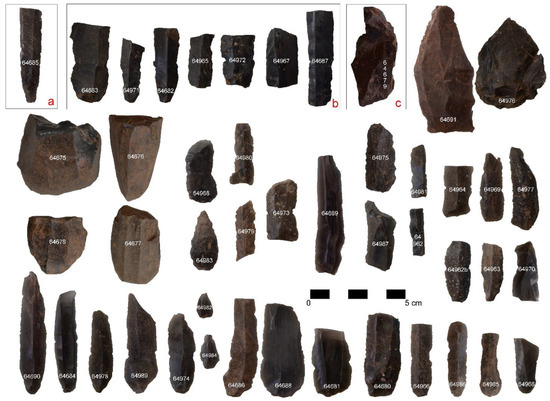
Figure 4.
Obsidian artifacts from Valdesi: (a) Sardinia, (b) Pantelleria; center: core, mesial, and distal fragments; bottom: whole pieces and proximal fragments. (c) is slag.
4. Obsidian Sources and Subsources in the South–Central Mediterranean
The geological sources of obsidian on Lipari [16,17,18], Pantelleria [19], and the other central Mediterranean source islands have been documented. Lipari is just 23 km of open-water travel from northern Sicily, and there are two source subgroups, Gabellotto Gorge and Canneto Dentro, both formed during the Mesolithic period [20]. These two prehistoric subsources may be chemically distinguished, while the more extensive outcrops of Gabellotto Gorge constituted a very large percentage of what was used. Canneto Dentro is a small geological outcrop that was used only to a very minor extent. The valley and the upper north side of Gabellotto Gorge also may be chemically distinguished. Obsidian was widely used by residents of Lipari and transported/traded elsewhere in the central Mediterranean from the Early Neolithic (starting ca. 6000 BCE), with great intensification throughout Italy by the Late Neolithic [21].
A detailed geological survey and analysis were also performed on Pantelleria, about 100 km from southwestern Sicily, with chemical differentiation between two areas in the northern part of the island and three groups at Balata dei Turchi, representing different volcanic events over a few hundred thousand years [19,22,23,24]. Identifying the specific subsource used on Pantelleria, which includes large blocks on the southern coastline of Balata dei Turchi and smaller sizes from the two Lago di Venere subsources to the north, is archaeologically important for addressing access to and knowledge about the visiting collectors during the Neolithic, when Pantelleria appears not to have been regularly inhabited.
5. Analytical Methods and Results
Techno-typological studies of the obsidian artifacts were performed first, identifying the kind of artifact (e.g., blade, flake, waste), whether it was worked (e.g., retouch or use-wear), and its physical appearance (presence of phenocrysts, transparency). In this study, all but a few were blades or blade fragments, while four cores were present. The very few flakes and waste suggest that the tools may not have been produced at this specific site or perhaps constituted an aesthetic selection of the pieces. These variables are important to incorporate into our interpretation of obsidian artifact production, usage, and comparisons with other lithic materials, as well as whether there were changes for different periods [25,26,27].
Successful scientific analyses to distinguish different obsidian sources began in the 1960s using optical emission spectroscopy [28], and by the 1970s, the use of neutron activation analysis clearly separated the Mediterranean island sources [29]. The first significant study in Sicily was for the Early Neolithic site of Grotta dell’Uzzo [30], west of Palermo, where 152 artifacts were analyzed by X-ray fluorescence spectrometry, and both Lipari (61%) and Pantelleria (39%) were identified.
Over the past two decades, several analytical methods have been shown to be successful in distinguishing the Central Mediterranean obsidian sources, including ED-XRF [31]; ED-XRF and PIXE [32]; ED-XRF and WD-XRF at the Università della Calabria [33]; SEM-EDS, ED-XRF, PIXE, and LA-ICP-MS at the Université Bordeaux Montaigne, Maison de l’Archéologie [34]; PGAA at the Nuclear Analysis and Radiography Department, Centre for Energy Research, Hungarian Academy of Sciences [35]; and non-destructive portable XRF [16,36,37,38,39,40,41,42].
One study looked at a combined 57 obsidian artifacts from six sites near Milena in central Sicily, with Lipari (77%) and Pantelleria (23%) represented in similar proportions to Uzzo [31]. Virtually all other studies performed by G. Pappalardo and/or L. Pappalardo in the laboratory at the University of Catania, however, were on sites from the province of Catania and with very small percentages (if any) of obsidian from Pantelleria [32].
The ability to conduct non-destructive XRF analyses of any size artifact with a commercially produced, portable hand-held X-ray fluorescence spectrometer has revolutionized the studies of obsidian artifacts in the central Mediterranean, providing the opportunity for artifacts to remain in museums and storage facilities. More than 3400 analyses of obsidian artifacts from Sicily have been performed by the first author [7,43]. Starting in 2007, the author has used three different models of the Bruker Tracer pXRF (III-V+, III-SD, Vi), each calibrated with 40 geological obsidian samples also tested by neutron activation analysis, regular XRF, and ICP-mass spectrometry at the Research Reactor Lab at the University of Missouri [44]. In addition, an extensive number of geological samples from all four central Mediterranean sources have also been tested with each instrument model, allowing for direct comparisons with results from artifacts analyzed [38,39,40,41]. All of the Mediterranean obsidian sources are distinguishable from each other using the trace elements rubidium, strontium, yttrium, zirconium, and niobium (Figure 5, with only Sr/Nb vs. Rb/Nb), as can the subsources Lipari–Gabellotto from Lipari–Canneto Dentro and Pantelleria-Balata dei Turchi from Pantelleria–Lago di Venere 1 and 2 (Figure 6, with only Rb/Sr vs. Fe/Sr; Figure 7 with only Zr vs. Rb).

Figure 5.
Rb, Sr, and Nb ratios for geological samples showing separation for European and Mediterranean obsidian sources.
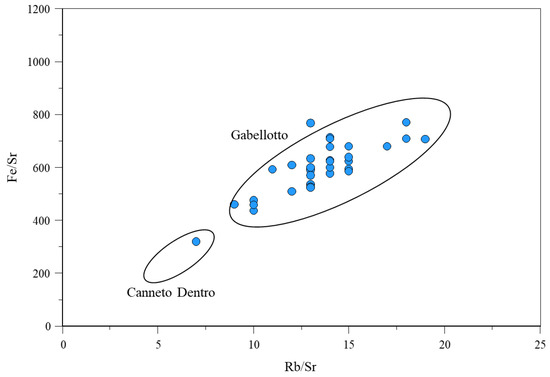
Figure 6.
Rb, Sr, and Fe ratios for Valdesi artifacts (blue) showing the Lipari subsources. Ellipses based on geological samples.
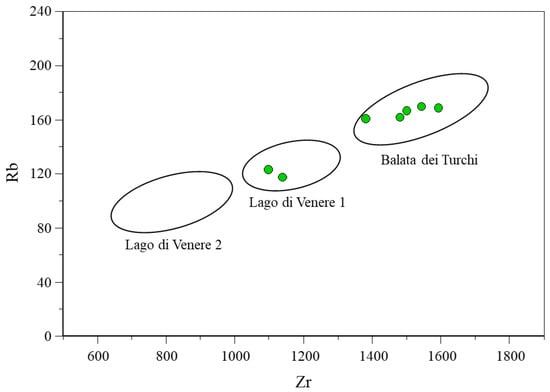
Figure 7.
Zr and Rb values in ppm for Valdesi artifacts (green) showing the Pantelleria subsources.
Pantelleria obsidian is peralkaline and has much greater amounts than Lipari of the trace elements zirconium (Zr), niobium (Nb), and yttrium (Y). On Pantelleria, there are chronologically separate major flows at Balata dei Turchi along the southern coast and two smaller deposits near Lago di Venere in the northeast, with chemical signatures for each [19,40].
Lipari obsidian may be distinguished from other Mediterranean sources using graphs with Rb/Nb vs. Sr/Nb ratios, and the specific concentration of strontium distinguishes between the Lipari subsources of Gabellotto Gorge and Canneto Dentro [16,39,40,45]. Careful comparisons of other sources using the data for all individual elements were performed.
For the 42 Valdesi obsidian artifacts, analyses were performed within the Antonino Salinas Regional Archeological Museum, using the Bruker Tracer III-SD with settings of 40 kV, 11 μA, and run time of 120 s (Table 1). Of the seven artifacts tested in this study that were assigned to Pantelleria, five came from Balata dei Turchi (Pa-BdT), and two came from the Lago di Venere 1 (Pa-LdV1) subsource. Thirty-four of the 35 artifacts assigned to Lipari were attributed specifically to Gabellotto Gorge (Li-GG) and one to Canneto Dentro (Li-CD). Surprisingly, one artifact was assigned to Sardinia (Monte Arci), the first found anywhere in Sicily (Figure 4a). The specific attribution to subsource SB2 was confirmed with the trace element values obtained for Sr, Y, and Nb (see Table 2, sample 64685).

Table 1.
Number of Valdesi artifacts assigned to each obsidian subsource.

Table 2.
Obsidian artifacts from Valdesi tested in this study.
6. Discussion
At this point, more than 5400 obsidian artifacts from about 90 different sites in Sicily and Malta have been analyzed, about 3800 by the first author (Table 1). Fifty of these sites had at least 10 obsidian artifacts, allowing for some statistical comparisons (Figure 8). It is important to note the broad time range during which obsidian was used in Sicily, from the beginning of the Neolithic until at least the Middle Bronze Age (ca. 6000–1500 BC) (Figure 9). Over that long time frame, there were changes in lithic technology, the introduction of copper and bronze metallurgy, and increasing political and economic complexity.
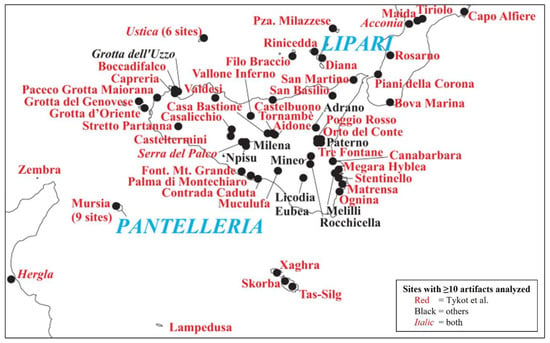
Figure 8.
Sicily sites with 10 or more artifacts tested. Obsidian sources are Lipari and Pantelleria. The blue are the source islands.
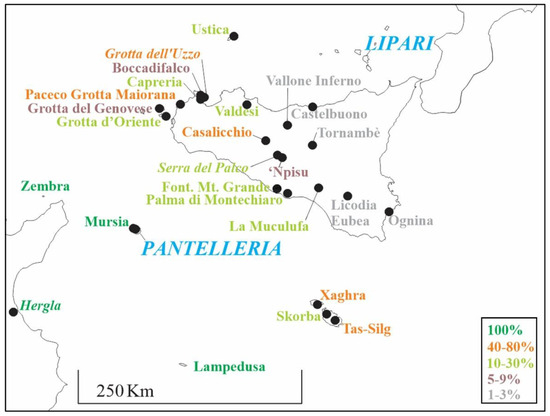
Figure 9.
Pantelleria obsidian decreases with distance, with little in eastern Sicily. Not shown are the 22 sites with no Pantelleria obsidian.
The direct open-water distance from the westernmost Aeolian Island of Alicudi to Valdesi is nearly 100 km, but by going along the northern coast of Sicily, only about 20 km at sea from Vulcano to Milazzo or Gioiosa Marea was necessary. Yet the small island of Ustica, 50 km north of Palermo, is thought to have had a direct connection from Alicudi [45,46,47,48]. Pantelleria, however, is about 100 km to the south of Sicily, plus coastal and/or overland travel to Valdesi. For the Neolithic time period, we have no direct evidence for the open-water vessels that were used [49], but it is thought that a daily trip of more than 100 km may have required sails. Whatever the routes used, the distance traveled from Lipari to Valdesi was about 150 km and nearly 200 km from Pantelleria, indicating the long-distance regular interactions that occurred in Sicily and the central Mediterranean during the Chalcolithic.
Of the 50 sites in Sicily with ≥10 obsidian artifacts tested, the percentage of Pantelleria obsidian decreases with distance (Figure 9). The inland site of Casalicchio is especially high, with >55% Pantelleria obsidian, while all sites further east have 25% or less, with many of the assemblages having no Pantelleria obsidian, especially in the eastern half of Sicily.
The relative amounts of obsidian from Lipari and Pantelleria may be due to multiple cultural and practical variables. Obsidian artifacts are found in multiple types, including complete tools, broken blades, and flakes or debitage from the initial production. The artifacts found in a particular context may originate from the same core(s). Our interpretation is that initial preparation was conducted close to the geological sources, while final tools were produced at or near residential sites even farther away. Obsidian artifacts made of Lipari material have been found throughout Italy and especially in Sicily from the Early Neolithic to the Bronze Age [50,51]. On the island of Lipari, there is archaeological evidence at sites such as Contrada Diana of specialists producing preformed cores in great abundance, clearly for transport to Sicily and beyond [21]. In eastern Sicily, wide blades were produced during the Neolithic [26]. In our study of obsidian artifacts from Valdesi in western Sicily, some came from Pantelleria, and the visual, physical, and practical differences between these two sources may have led to selection practices [16].
The comparison of obsidian assemblages from one archaeological site with another must be performed carefully, considering periods and contexts. There were significant economic changes from egalitarian societies in the Early Neolithic during the 6th millennium BCE to more complex sites and specialists by the Early Bronze Age at the end of the 4th millennium BCE. For maritime travel, obsidian was unlikely the only material being transported, while pathways most likely were along coasts when possible. Obsidian from Pantelleria, with a much greater open-water distance of 100 km than for Lipari (20 km), may have been transported with less frequency, as well as seasonally.
At Valdesi, the relative proportions of Lipari and Pantelleria obsidian were thus due to a combination of visual and physical properties for each source, practical aspects including distance and routes over sea and land, and the particular activities that occurred at the site.
7. Conclusions
Significant is the reach of obsidian from Sardinia to southern Italy, with one piece identified in Sicily at the site of Valdesi. Given the identification of a few pieces of Sardinia obsidian at sites in Calabria and elsewhere in southern Italy, including in the toe at Bova Marina, this find in Sicily does not suggest open-water travel directly from Sardinia during the Chalcolithic but further supports the idea of down-the-line exchange from central to southern Italy and Sicily.
We still need to investigate further the actual usage of obsidian compared with other lithic materials and how that usage may be related to the introduction of the agricultural package. In general, it appears that obsidian cores were produced near geological sources and transported over great distances to sites where blades and flakes were produced on a mostly local basis. Even when constituting a small percentage of the total stone tools, obsidian does not appear specifically in burial, ritual, or other special contexts; rarely had undergone retouching; and was not used to any great extent before being discarded. While sourcing studies of obsidian in Sicily and the southern central Mediterranean have been quite extensive, there are important research questions still to be addressed.
The routes taken from Pantelleria and Lipari to Valdesi and other sites in northwestern Sicily remain our main research question. The identification of one artifact from Sardinia separately supports transportation and connections over great distances in the central Mediterranean.
Author Contributions
Conceptualization (R.H.T., V.F., F.F.M.); methodology and analysis (R.H.T.); writing, review, editing (R.H.T., V.F., F.F.M.). All authors have read and agreed to the published version of the manuscript.
Funding
This research received no external funding.
Data Availability Statement
All data are included in this article.
Acknowledgments
We thank the director of the Antonino Salinas Regional Archeological Museum during our research, Francesca Spatafora, for permission and access to the Valdesi obsidian collection.
Conflicts of Interest
The authors declare no conflict of interest.
References
- Tykot, R.H. Obsidian Procurement and Distribution in the Central and Western Mediterranean. J. Mediterr. Archaeol. 1996, 9, 39–82. [Google Scholar] [CrossRef]
- Tykot, R.H. Chemical Fingerprinting and Source-Tracing of Obsidian: The Central Mediterranean Trade in Black Gold. Acc. Chem. Res. 2002, 35, 618–627. [Google Scholar] [CrossRef]
- Agnesi, V. (Ed.) La geomorfologia di Palermo; Sapienza Università Editrice 24: Roma, Italy, 2021. [Google Scholar]
- Agnesi, V. La montagna sacra, ovvero, miti leggende e misteri di Monte Pellegrino. In Miti e leggende della geologia in Sicilia; Villaggio Letterario: Napoli, Italy, 2023. [Google Scholar]
- Cappadonia, C.; Di Maggio, C.; Agate, M.; Agnesi, V. Geomorphology of the urban area of Palermo (Italy). J. Maps 2020, 16, 274–284. [Google Scholar] [CrossRef]
- Agate, M.; Di Maggio, C. Assetto geologico della Piana di Palermo e dei monti circostanti. In La geomorfologia di Palermo; Agnesi, V., Ed.; Sapienza Università Editrice: Roma, Italy, 2021; pp. 7–14. [Google Scholar]
- Agate, M.; Di Maggio, C. Una storia geologica lunga 230 milioni di anni. In La geomorfologia di Palermo; Agnesi, V., Ed.; Sapienza Università Editrice: Roma, Italy, 2021; pp. 15–24. [Google Scholar]
- Di Maida, G. 3D in the cave: Hey young deer, why the long face (and no tail). Rock Art Res. 2016, 33, 209. [Google Scholar]
- Mannino, G. Le grotte di Monte Pellegrino; Etna Madonie del Gruppo Alpino Siciliano: Palermo, Italy, 1985; p. 245. [Google Scholar]
- Salinas, E. Ricerche paletnologiche intorno al Monte Pellegrino presso Palermo. In Notizie degli Scavi; NSA: Fort Meade, MD, USA, 1907; pp. 307–313. [Google Scholar]
- De Gregorio, A. Iconografia Delle Collezioni Preistoriche Della Sicilia; Annales del Geologie et de Paleontologie, 33–34 Sivrason, Palermo; Edizioni Librarie Siciliane: Sicilia, Italy, 1917; pp. 23–28. [Google Scholar]
- Bovio Marconi, J. La Coltura Tipo Conca d’Oro della Sicilia Nord-Occidentale; Tipografia dell’Accademia d’Italia: Milano, Italy, 1944. [Google Scholar]
- Mannino, G. Monte Pellegrino nella Preistoria, Nuovi Dati. Not. Archeol. Della Soprintend. Di Palermo 2017, 24, 1–28. [Google Scholar]
- Tusa, S. La Sicilia nella Preistoria; Sellerio Editore Palermo: Palermo, Italy, 1992. [Google Scholar]
- Giannitrapani, E. Calib_Sicily: A new radiocarbon dataset for prehistoric Sicily. Spatiotemporal dynamics from ca. 6.500 to 1.500 cal. BCE. Archeol. Data III 2023, 2023, 153–166. [Google Scholar] [CrossRef]
- Tykot, R.H. Geological Sources of Obsidian on Lipari and Artifact Production and Distribution in the Neolithic and Bronze Age Central Mediterranean. Open Archaeol. 2019, 5, 83–105. [Google Scholar] [CrossRef]
- Tykot, R.H.; Iovino, M.R.; Martinelli, M.C.; Beyer, L. Ossidiana da Lipari: Le fonti, la distribuzione, la tipologia e le tracce d’usura. In Proceedings of the Atti del XXXIX Riunione Scientifica dell’Istituto Italiano di Preistoria e Protostoria: Materie Prime e Scambi nella Preistoria Italiana, Firenze, Italy, 25–27 November 2004; pp. 592–597. [Google Scholar]
- Martinelli, M.C.; Coltelli, M.; Manni, M.; Bonizzoni, L.; Guglielmetti, A.; Oddone, M.; Balestrieri, M.L. Prehistorical Obsidian Sources in the Island of Lipari (Aeolian Islands). Open Archaeol. 2020, 6, 393–402. [Google Scholar] [CrossRef]
- Francaviglia, V. Ancient obsidian sources on Pantelleria (Italy). J. Archaeol. Sci. 1988, 15, 109–122. [Google Scholar] [CrossRef]
- Forni, F.; Lucchi, F.; Peccerillo, A.; Tranne, C.A.; Rossi, P.L.; Frezzotti, M.L. Stratigraphy and geological evolution of the Lipari volcanic complex (cental Aeolian archipelago). In The Aeolian Islands Volcanoes (Vol. Memoir No. 37); Lucchi, F., Peccerillo, A., Keller, J., Tranne, C.A., Rossi, P.L., Eds.; Geological Society: London, UK, 2013; pp. 213–279. [Google Scholar]
- Martinelli, M.C.; Tykot, R.H.; Vianello, A. Lipari (Aeolian Islands) obsidian in the Late Neolithic. Artifacts, supply and function. Open Archaeol. 2019, 5, 46–64. [Google Scholar] [CrossRef]
- Tykot, R.H.; Vargo, B.A.; Bliss, J.; Colella, V.; Tosi, M.; Tusa, S. Geoarchaeological Survey of Obsidian Sources on Pantelleria (Italy), 102nd Annual Meeting of the Archaeological Institute of America, January 3–6, San Diego. Am. J. Archaeol. 2001, 105, 280. [Google Scholar]
- Tufano, E.; D’Amora, A.; Trifuoggi, M.; Tusa, S. L’ossidiana di Pantelleria: Studio di caratterizzazione e provenienza alla luce della scoperta di nuovi giacimenti. In Atti della XLI Riunione Scientifica dell’Istituto Italiano di Preistoria e Protostoria; Istituto Italiano di Preistoria e Protostoria: Firenze, Italy, 2012; pp. 840–849. [Google Scholar]
- Rotolo, S.G.; Carapezza, M.L.; Correale, A.; Foresta Martin, F.; Hahn, G.; Hodgetts, A.G.E.; La Monica, M.; Nazzari, M.; Romano, P.; Sagnotti, L.; et al. Obsidians of Pantelleria (Strait of Sicily): A Petrographic, Geochemical and Magnetic Study of Known and New Geological Sources. Open Archaeol. 2020, 6, 434–453. [Google Scholar] [CrossRef]
- Freund, K.P.; Tykot, R.H. Lithic technology and obsidian exchange networks in Bronze Age Nuragic Sardinia (Italy). Archaeol. Anthropol. Sci. 2011, 3, 151–164. [Google Scholar] [CrossRef]
- Freund, K.P.; Tykot, R.H.; Vianello, A. Blade production and the consumption of obsidian in Stentinello period Neolithic Sicily. Comptes Rendus Palevol 2015, 14, 207–217. [Google Scholar] [CrossRef]
- Freund, K.P.; Tykot, R.H.; Vianello, A. Contextualizing the Role of Obsidian in Chalcolithic Sicily (c. 3500–2500 BC). Lithic Technol. 2017, 42, 35–48. [Google Scholar] [CrossRef]
- Cann, J.R.; Renfrew, C. The characterization of obsidian and its application to the Mediterranean region. Proc. Prehist. Soc. 1964, 30, 111–133. [Google Scholar] [CrossRef]
- Hallam, B.R.; Warren, S.E.; Renfrew, C. Obsidian in the western Mediterranean: Characterisation by neutron activation analysis and optical emission spectroscopy. Proc. Prehist. Soc. 1976, 42, 85–110. [Google Scholar] [CrossRef]
- Francaviglia, V.; Piperno, M. La repartition et la provenance de l’obsidiene archaeologique de la Grotta dell’Uzzo et de Monte Cofano (Sicile). Rev. D’archéométrie 1987, 11, 31–39. [Google Scholar] [CrossRef]
- La Rosa, V.; Palio, O.; Pappalardo, G.; Pappalardo, L.; Romano, F.P. Analisi delle provenienze di ossidiane dal territorio di Milena (Caltanissetta). In Atti della XXXIX Riunione Scientifica. Materie Prime e Scambi nella Preistoria Italiana; Istituto Italiano di Preistoria e Protostoria I: Firenze, Italy, 2006; pp. 499–508. [Google Scholar]
- Pappalardo, L.; Romano, F.P.; Bracchitta, D.; Massimino, A.; Palio, O.; Rizzo, F. Obsidian provenance determination using the beam stability controlled BSC-XRF and the PIXE-alpha portable spectrometers of the LANDIS laboratory: The case of Via Capuana settlement in Licodia Eubea (Sicily). J. Geophys. Eng. 2013, 10, 064004. [Google Scholar] [CrossRef]
- De Francesco, A.M.; Crisci, G.M.; Bocci, M. Non-destructive Analytical Method Using XRF for Determination of Provenance of Archaeological Obsidians from the Mediterranean Area: A Comparison with Traditional XRF Methods. Archaeometry 2008, 50, 337–350. [Google Scholar] [CrossRef]
- Orange, M.; Le Bourdonnec, F.-X.; Bellot-Gurlet, L.; Lugliè, C.; Dubernet, S.; Bressy-Leandri, C.; Scheffers, A.; Joannes-Boyau, R. On sourcing obsidian assemblages from the Mediterranean area: Analytical strategies for their exhaustive geochemical characterization. J. Archaeol. Sci. Rep. 2017, 12, 834–844. [Google Scholar] [CrossRef]
- Kasztovszky, Z.; Maróti, B.; IHarsányi, I.; Párkányi, D.; Szilágyi, V. A comparative study of PGAA and portable XRF used for non-destructive provenancing archaeological obsidian. Quat. Int. 2018, 468, 179–189. [Google Scholar] [CrossRef]
- Tykot, R.H. Sourcing of Sardinian Obsidian Collections in the Museo Preistorico-Etnografico ‘Luigi Pigorini’ Using Non-Destructive Portable XRF. In L’ossidiana del Monte Arci nel Mediterraneo. Nuovi Apporti sulla Diffusione, sui Sistemi di Produzione e Sulla loro Cronologia. Atti del 5° Convegno Internazionale (Pau, Italia, 27–29 Giugno 2008); Lugliè, C., Ed.; NUR: Ales, Italy, 2010; pp. 85–97. [Google Scholar]
- Tykot, R.H. Obsidian Finds on the Fringes of the Central Mediterranean: Exotic or Eccentric Exchange? In Exotica in the Prehistoric Mediterranean; Vianello, A., Ed.; Oxbow Books: Oxford, UK, 2011; pp. 33–44. [Google Scholar]
- Tykot, R.H. Using Non-Destructive Portable X-Ray Fluorescence Spectrometers on Stone, Ceramics, Metals, and Other Materials in Museums: Advantages and Limitations. Appl. Spectrosc. 2016, 70, 42–56. [Google Scholar] [CrossRef]
- Tykot, R.H. A Decade of Portable (Hand-Held) X-ray Fluorescence Spectrometer Analysis of Obsidian in the Mediterranean: Many Advantages and Few Limitations. MRS Adv. 2017, 2, 1769–1784. [Google Scholar] [CrossRef]
- Tykot, R.H. Obsidian Studies in the Prehistoric Central Mediterranean: After 50 Years, What Have We Learned and What Still Needs to Be Done? Open Archaeol. 2017, 3, 264–278. [Google Scholar] [CrossRef]
- Tykot, R.H. Non-Destructive pXRF on Prehistoric Obsidian Artifacts from the Central Mediterranean. Appl. Sci. 2021, 11, 7459. [Google Scholar] [CrossRef]
- Mameli, V.; Angotzi, M.S.; Farinini, E.; Leardi, R.; Lugliè, C.; Cannas, C. Intra-source provenance study on Monte Arci (Sardinia) obsidian by pXRF: Role of the data acquisition and analysis tools. Heliyon 2023, 9, e13958. [Google Scholar] [CrossRef] [PubMed]
- Tykot, R.H. Open-Water Travel for Obsidian to Sicily and other South-Central Mediterranean Islands. In Proceedings of the Atti del LVII Riunione Scientifica dell’Istituto Italiano di Preistoria e Protostoria, Periplous: Il mare nella Preistoria mediterranea, Siracusa, Italy, 19–22 October 2022. [Google Scholar]
- Glascock, M.D.; Ferguson, J.R. Report on the Analysis of Obsidian Source Samples by Multiple Analytical Methods; Archaeometry Lab, University of Missouri Research Reactor: Columbia, MO, USA, 2012. [Google Scholar]
- Tykot, R.H.; Foresta Martin, F. Analysis by pXRF of Prehistoric Obsidian Artifacts from Several Sites on Ustica (Italy): Long-Distance Open-Water Distribution from Multiple Island Sources during the Neolithic and Bronze Ages. Open Archaeol. 2020, 6, 348–392. [Google Scholar] [CrossRef]
- Foresta Martin, F.; Di Piazza, A.; D’Oriano, C.; Carapezza, M.L.; Paonita, A.; Rotolo, S.G.; Sagnotti, L. New Insights into the Provenance of the Obsidian Fragments of the Island of Ustica (Palermo, Sicily). Archaeometry 2017, 59, 435–454. [Google Scholar] [CrossRef]
- Foresta Martin, F.; Tykot, R.H. Characterization and Provenance of Archaeological Obsidian from Pirozza-Spalmatore, a Site of Neolithic Colonization on the Island of Ustica (Sicily). Open Archaeol. 2019, 5, 4–17. [Google Scholar]
- Speciale, C.; Iovino, M.R.; Freund, K.; de Vita, S.; Larosa, N.; Battaglia, G.; Tykot, R.H.; Vassallo, S. Obsidian from the site of Piano dei Cardoni, Ustica (Palermo, Italy): New Insights on the Prehistoric Occupation of the Island. Open Archaeol. 2021, 7, 273–290. [Google Scholar] [CrossRef]
- Robb, J.E.; Farr, H. Substances in motion: Neolithic Mediterranean “trade”. In The Archaeology of Mediterranean Prehistory; Blake, E., Knapp, A.B., Eds.; Blackwell: Hoboken, NJ, USA, 2005; pp. 24–45. [Google Scholar]
- Tykot, R.H.; Freund, K.P.; Vianello, A. Source Analysis of Prehistoric Obsidian Artifacts in Sicily (Italy) using Pxrf. In Archaeological Chemistry VIII; Armitage, R.A., Burton, J.H., Eds.; ACS Symposium Series; ACS: Washington, DC, USA, 2013; Volume 1147, pp. 195–210. [Google Scholar]
- Vianello, A.; Tykot, R.H. Exchange Networks from Close-Up: The Case of Lipari Obsidian. J. Lithic Stud. 2016, 3, 1–16. [Google Scholar] [CrossRef]
Disclaimer/Publisher’s Note: The statements, opinions and data contained in all publications are solely those of the individual author(s) and contributor(s) and not of MDPI and/or the editor(s). MDPI and/or the editor(s) disclaim responsibility for any injury to people or property resulting from any ideas, methods, instructions or products referred to in the content. |
© 2023 by the authors. Licensee MDPI, Basel, Switzerland. This article is an open access article distributed under the terms and conditions of the Creative Commons Attribution (CC BY) license (https://creativecommons.org/licenses/by/4.0/).